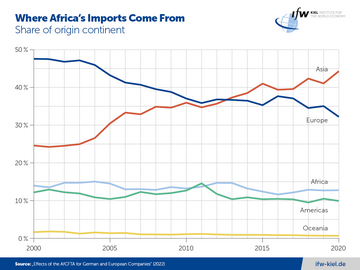News
Africa's free trade plans open up new opportunities

The African Continental Free Trade Area (AfCFTA), which entered into force in May 2019, is in many respects a historic milestone towards trade liberalization and thus greater prosperity on the African continent. The elimination of tariffs within Africa has only marginal effects. More important, according to the authors of the study ”Effects of the AfCFTA for German and European Companies” (Hinz, J., Chowdhry, S., Jacobs, A., Thiele, R., October 2022), is the elimination of other trade barriers. However, the removal of trade barriers is far from automatic, and the EU and local companies can contribute their know-how to remove trade barriers efficiently and to the benefit of all.
”Our simulations show that AfCFTA can boost the so far persistently low intra-African trade. The most important lever for this is the removal of bureaucratic obstacles and other so-called non-tariff barriers (NTBs), rather than the removal of tariffs,” says Julian Hinz, trade researcher and lead author of the study. ”Just removing 10 percent of non-tariff barriers can trigger significant intra-African and global export growth.” Outside Africa, German firms could benefit substantially because of the special trade relationships that already exist today.
EU loses weight in Africa trade, Asia makes gains
The EU has become much less important for Africa's exports and imports in recent years, while Asia has gained: Between 2000 and 2020, the EU's share of Africa's exports fell from just under 50 to 35 percent, while Asia's share grew by almost 20 percentage points to around 30 percent in the same period. In terms of imports, Asia overtook the EU as the African continent's main import region as early as 2013. For the EU itself, Africa remains a minor trading partner, accounting for 2 percent of its exports. Germany is the second largest exporter and third largest importer within the EU with regard to AfCFTA countries and has a special position in terms of products: Machinery, electrical appliances, vehicles, and transport equipment are the main exports and imports. This is primarily due to Germany's involvement in South Africa.

Intra-African trade lags behind
Intra-African trade also gained importance, with around 25 percent of African countries' exports staying within the continent in 2020 compared with 12 percent in 2000. But despite this growth, intra-African trade is far weaker than in more integrated economies such as the EU.
Based on simulations with the KITE international trade model, the authors expect among others the following medium- to long-term effects of AfCFTA:
- The elimination of all tariffs among AfCFTA members alone has a small impact on trade and national incomes of participating countries.
- If, in addition, other trade barriers (NTBs), such as import quotas, are reduced by 10 percent within the AfCFTA, global exports of AFCFTA members could be 17 percent higher annually than without these measures, and intra-African exports could be nearly 23 percent higher. Countries could expect an 11 percent increase in their annual income and a 24 percent increase in output (price-adjusted).
- If the reduction of NTBs is extended to countries outside the AfCFTA, the positive effect is amplified: annual global exports of the participating countries would then be 22 percent higher, and exports to the EU almost 30 percent higher. Income would be 18 percent higher and production 29 percent higher.
”AfCFTA can have a significantly positive effect for the African countries involved. The prerequisite is that, in addition to tariffs, other trade barriers such as import quotas and customs bureaucracy are eliminated. If the latter also applies to third parties, the AfCFTA countries would benefit additionally, but so would the EU countries, for example. The EU and Germany should therefore focus on assisting the AfCFTA countries in removing non-tariff trade barriers with the implementation of the agreement. Public institutions and companies from the EU can, for example, help modernize the AfCFTA countries' customs procedures and infrastructure,” says Julian Hinz. ”European and especially German exporters to AfCFTA countries would hardly have to worry about their exports being displaced by intra-African exports, according to our simulation results.”
The study was conducted with the support of Deutsche Gesellschaft für Internationale Zusammenarbeit (GIZ) GmbH on behalf of the Federal Ministry for Economic Cooperation and Development (BMZ).